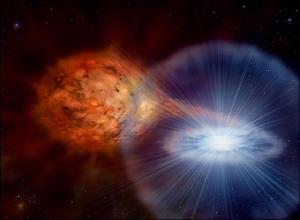Post
Not So Super Nova
22 August 2013
 David A Hardy
David A HardyLast year there was a new nova in the night sky, now officially named Nova Delphini 2013. From Earth, it looked like a fairly dim new star in the constellation Delphinus. Novae such as this one are similar to the more popular supernovae. The popular view of a supernova is that of an exploding star. A large star runs out of hydrogen to fuel, and as a result collapses upon itself. This “core collapse” causes intense nuclear reactions which rip the star apart in a huge explosion, which is why this type of supernova is known as a core-collapse supernova.
There’s another type of supernova known as a thermal runaway supernova. This occurs when a white dwarf is in a close binary system with a red giant star. Material from the red giant is captured by the white dwarf, adding to its mass. But there is a limit to how much mass a white dwarf can have (known as the Chandrasekhar limit). As the this limit is reached, the star begins to collapse. This causes a cascade of rapid fusion within its core, which rips the white dwarf apart. The white dwarf explodes as a supernova. You can read about the details in an earlier post.
A nova is similar to a thermal runaway supernova. It too is produced by a white dwarf orbiting a red giant. When a supernova is triggered the entire white dwarf is ripped apart in a catastrophic explosion. With a nova, the hydrogen and helium captured from the red dwarf compresses on the surface of the white dwarf. The heat and pressure from this gravitational compression triggers a fusion reaction of the material. The result is a thermonuclear explosion that is not intense enough to destroy the star, but still produces a massive brightening of the star. You can see an artistic take on such an event in the image above.
Because the white dwarf is not destroyed by the nova, it is possible for the same star to go nova multiple times. Perhaps the most famous example of such a repeating nova is RS Ophiuchi, which has erupted six times since 1898. If RS ophiuchi continues to accrete mass, it will eventually reach the Chandrasekhar limit and become a supernova.
There are about 10 observed novae in our galaxy every year, but it is unusual for one to be bright enough to see with the naked eye or small telescope. So if you ever have the chance to look at such a new cosmic explosion, it’s worth checking out.